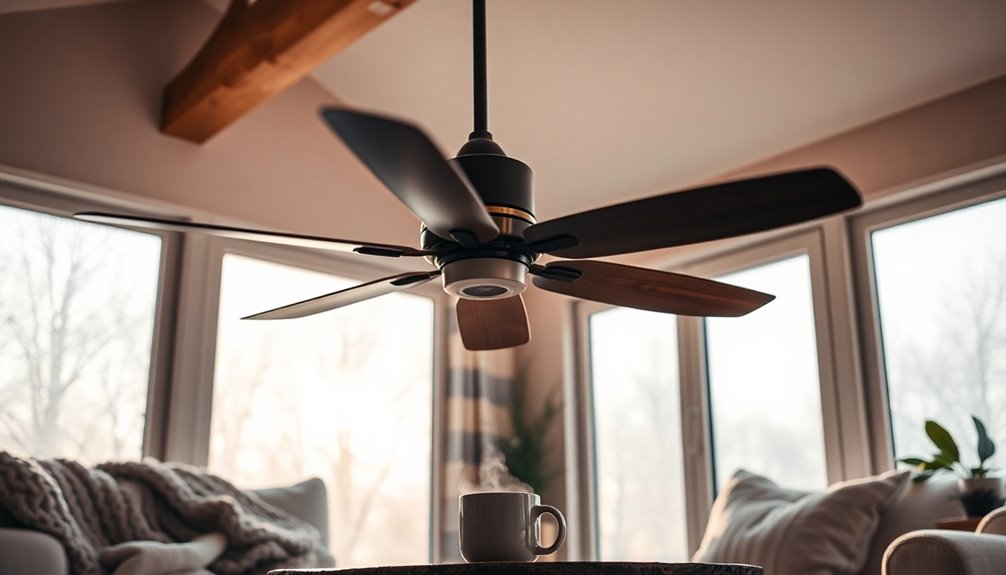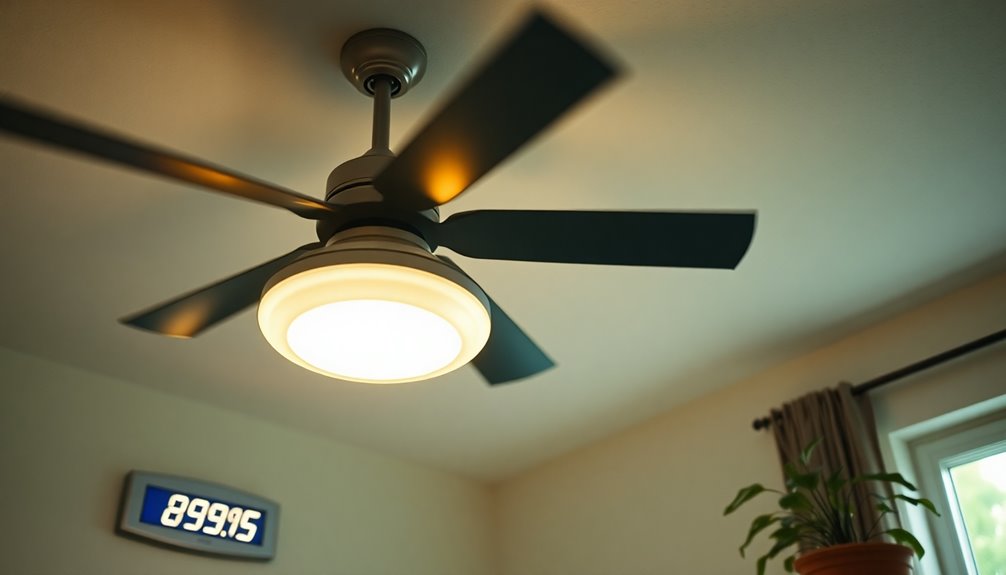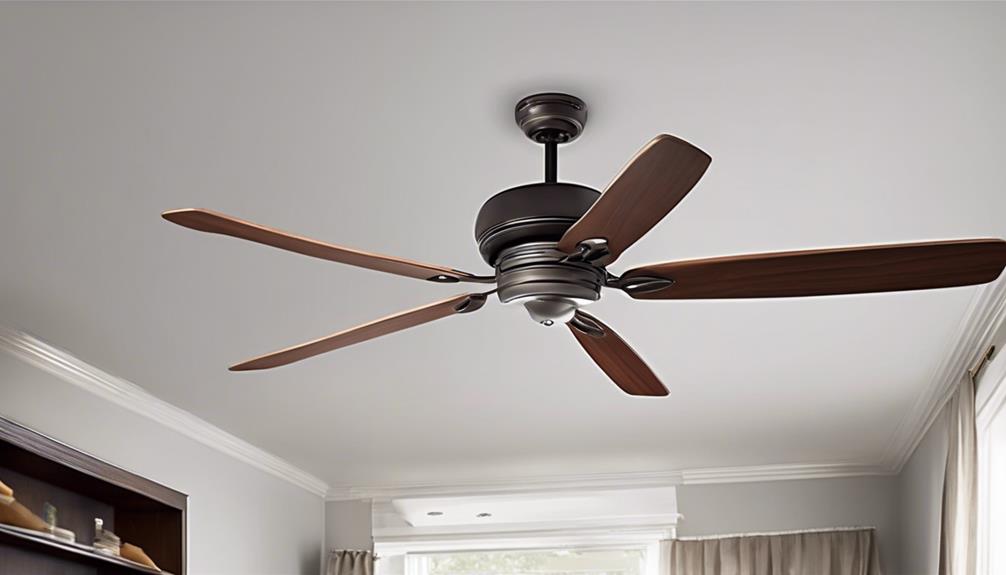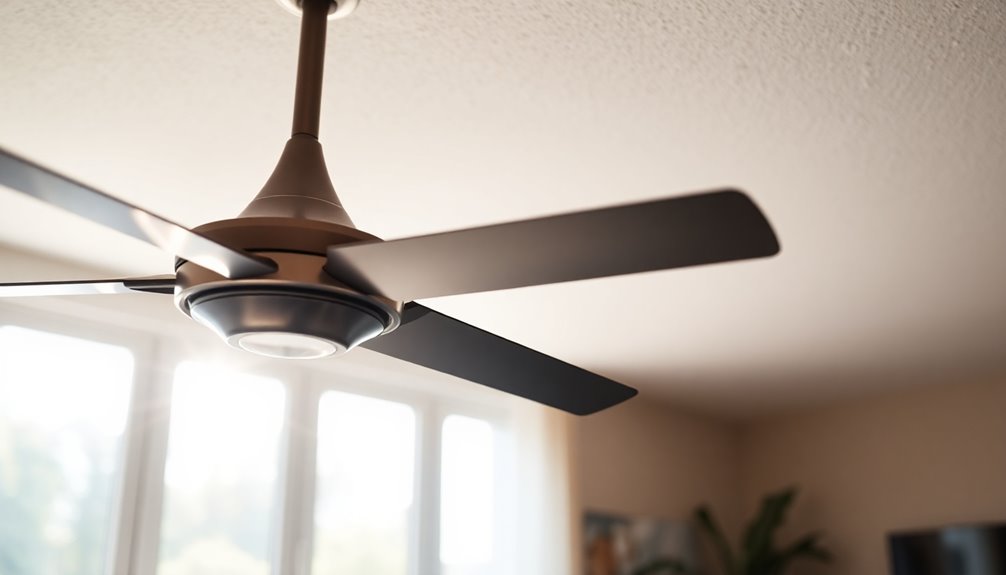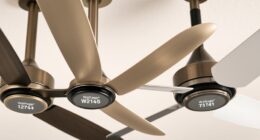To stay cozy during winter, set your ceiling fan to rotate clockwise. This direction creates an updraft that pushes warm air down, helping to heat your space effectively. Make sure to do this at low speed for gentle airflow, as it helps eliminate cold spots and can even lower your heating costs by up to 15%. It's easy to change the direction; just turn off the fan first, find the reversing switch, and switch it. Keeping your fan properly adjusted can make a significant difference. There's more to optimizing your fan for winter comfort ahead.
Key Takeaways
- Set your ceiling fan to rotate clockwise in winter to create an updraft that redistributes warm air.
- Running the fan at low speed enhances warmth and reduces heating costs by up to 15%.
- Change fan direction as winter approaches, ideally around Daylight Savings Time for optimal energy efficiency.
- Always turn off the fan before adjusting the direction to ensure safety and proper operation.
- Regularly check fan direction during the season to maintain consistent room temperature and comfort.
Importance of Ceiling Fan Direction

When it comes to your comfort during the winter months, the direction of your ceiling fan plays an essential role. Setting your ceiling fan to rotate clockwise creates an updraft that helps redistribute warm air accumulated near the ceiling down towards your living space.
This simple adjustment prevents cold spots and greatly enhances your overall comfort. Running your fan at a low speed in this direction can also lead to impressive energy savings, reducing heating costs by up to 10%.
By maintaining lower thermostat settings, you not only save money but also improve the efficiency of your heating system. This adjustment contributes to a more balanced indoor climate, allowing you to feel cozy without overworking your heater.
Most ceiling fans come equipped with a reversing switch located near the fan base, making it easy for you to make these seasonal adjustments. Ensuring your fan is set to the correct direction during winter can transform your home's heating experience, creating a more comfortable environment while maximizing energy efficiency.
How to Change Fan Direction

Changing your ceiling fan's direction for winter is a straightforward process that can greatly improve your comfort. To start, always turn off the fan and wait for it to come to a complete stop before making adjustments.
Next, locate the ceiling fan switch on the fan body or use the remote control to switch to clockwise rotation. If you have a smart fan, simply use the associated app or voice commands to access the reverse option.
Here's what you need to do:
- Set the fan to a low speed after changing the direction.
- This creates a gentle updraft that circulates warm air without causing drafts.
- After making the change, turn the fan back on and observe the rotation to confirm it's spinning clockwise.
This new fan direction in winter promotes ideal heat distribution throughout your space, enhancing energy efficiency while keeping you comfortable.
Don't forget to periodically check the fan direction to verify it's still functioning as intended. With these simple steps, you can enjoy a cozier atmosphere during the colder months!
Benefits of Clockwise Rotation

Adjusting your ceiling fan to rotate clockwise in winter offers several significant benefits that enhance your comfort and energy efficiency.
When set to this ceiling fan direction, the clockwise rotation creates an updraft that pulls cold air upwards, allowing warm air to be pushed down towards the floor for even warm air distribution. This means you can enjoy a more consistent temperature throughout the room without the uncomfortable drafts often associated with heating.
Running your ceiling fan at low speed during winter is energy efficient, helping to circulate warm air while maintaining a cozy atmosphere. This simple adjustment can lead to a reduction in heating costs by up to 15%, as you'll feel comfortable even with your thermostat set lower.
Additionally, using a clockwise rotation can help eliminate cold spots, further enhancing your overall comfort during the colder months.
Most ceiling fans come equipped with a reversing switch, making it easy for you to change the fan direction as the seasons shift.
Timing for Direction Change

As the seasons shift, it's essential to keep your ceiling fan's direction in sync with the temperature changes. Adapting to winter means you'll want to change your ceiling fan direction to clockwise. This simple adjustment helps circulate warm air that naturally rises to the ceiling back down into your living space, making your home more comfortable.
The best times to make this change are during Daylight Savings Time adjustments—when you spring forward or fall back.
Here's how you can effectively manage this seasonal adjustment:
- Turn off the fan and let it come to a complete stop.
- Use the reversing switch located on the fan body or your remote control.
- Confirm the fan size is appropriate for the room to maximize airflow.
Regularly changing the fan direction not only keeps your home cozy but also boosts energy efficiency throughout the year.
Common Misconceptions About Fan Use

Why do so many people overlook the benefits of ceiling fans in winter? A common misconception is that ceiling fans are only for cooling. In reality, they also help distribute warm air effectively. By setting your ceiling fan direction to clockwise rotation, you can enhance comfort and reduce heating costs by up to 15%.
Many mistakenly believe that changing the fan direction isn't necessary, but seasonal adjustments are essential for energy efficiency.
Another misconception is that fans cool rooms. Instead, they create air movement that makes you feel cooler in summer. In winter, running your fan at low speed can prevent drafts and maintain a steady temperature without lowering the room temperature.
Unfortunately, many individuals undervalue the importance of adjusting their fan direction as the seasons change. Not doing so can lead to inefficient warming and increased energy bills during colder months.
Frequently Asked Questions
How Do You Tell if Your Ceiling Fan Is Going Clockwise or Counterclockwise?
To tell if your ceiling fan's going clockwise or counterclockwise, stand directly under it and watch the blades.
If they move from the top left to the bottom right, it's rotating clockwise. If they move from the top right to the bottom left, it's counterclockwise.
Running the fan on low speed helps you see the direction more clearly without the wind chill effect messing with your perception.
Adjust it if needed using the reversing switch.
Which Direction Should a Ceiling Fan Go in Winter?
To maximize your comfort during winter, you'll want your ceiling fan to rotate clockwise. This direction creates an updraft, pulling cold air up while pushing warm air down towards the floor.
Running the fan at a low speed helps distribute warmth evenly without creating drafts. This adjustment can even reduce your heating costs, allowing you to keep your thermostat lower while staying cozy.
Check for a reversing switch to easily change your fan's direction.
Do Ceiling Fans Really Help in the Winter?
Imagine a cozy room where warmth dances from your heater, but cold pockets linger like unwelcome guests.
Ceiling fans can help chase those chill spots away. When you run your fan in winter, it creates an updraft that gently circulates the warm air, making your space feel more comfortable.
You'll notice a difference, and you might even save on heating costs. So, yes, those blades really do make a difference during the colder months!
What Direction Should I Face My Fan?
When you're deciding which direction to face your fan, consider its purpose.
If you want to create a cooling breeze, you should set it to rotate counterclockwise. This direction pushes air down, helping you feel cooler.
However, if you're looking for warmth, switch it to clockwise. This creates an updraft that helps circulate warm air throughout the room.
Adjust the speed as needed for maximum comfort while ensuring it's set correctly for your needs.
Conclusion
As winter wraps you in its cozy embrace, don't forget to give your ceiling fan a little nudge in the right direction. By switching it to clockwise, you'll gently coax warm air down, making your space feel just a bit snugger. Embrace this simple adjustment, and let the fan work its magic while you sip hot cocoa by the fire. With this small change, you'll keep comfort at your fingertips all season long. Enjoy the warmth!
